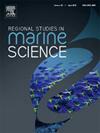Development of Artificial fish bait incorporated with Surimi and fatty acid bioattractant derived from seafood processing wastes for longline fishing
IF 2.1
4区 环境科学与生态学
Q3 ECOLOGY
引用次数: 0
Abstract
This study explored the possibilities of developing an artificial fish bait using a fish surimi gel matrix and attractants derived from shrimp, grouper, and tuna processing wastes. A wet rendering method was used to extract bioattractant from the wastes, which were characterized by their fatty acid using GC-MS. It resulted in a total of 37 fatty acids present in the different bioattractant. Among them, a high unsaturated degree of fatty acids (85.88 %) was found in the bioattractant derived from grouper, followed by tuna (64.62 %) and shrimp (62.35 %). A total of four different experimental baits were developed, including a surimi gel bait (SGB) as control, surimi gel bait with grouper bioattractant (SGB-GB), surimi gel bait with tuna bioattractant (SGB-TB), and surimi gel bait with shrimp bioattractant (SGB-SB) at three different level of concentrations viz., 1 %, 3 %, and 5 %. The developed baits were subjected to gel strength (GS), water holding capacity (WHC), expressible moisture content (EMC), fat leaching (FL), seawater stability, and attractability tests to standardize the ideal bait for commercial fishing. Fourier-Transom Infrared spectroscopy (FTIR) and Atomic Force Microscopy (AFM) were used to describe its molecular and microstructural features. AFM results displayed that the SGB-GB 5 % had a smooth and homogenous gel matrix with a low Ra value (19.11 nm), while the control bait (SGB) had a coarse and disorganized gel matrix with the highest Ra value (36.77 nm). In terms of fat leaching (86.34 %), seawater stability (81.69 %), attractability (28/30), gel strength (153.46 g/cm), EMC (13.52 %), and WHC (78 %), 5 % SGB-GB bait was found to be an ideal bait for commercial fishing.
求助全文
约1分钟内获得全文
求助全文
来源期刊

Regional Studies in Marine Science
Agricultural and Biological Sciences-Ecology, Evolution, Behavior and Systematics
CiteScore
3.90
自引率
4.80%
发文量
336
审稿时长
69 days
期刊介绍:
REGIONAL STUDIES IN MARINE SCIENCE will publish scientifically sound papers on regional aspects of maritime and marine resources in estuaries, coastal zones, continental shelf, the seas and oceans.
 求助内容:
求助内容: 应助结果提醒方式:
应助结果提醒方式:


